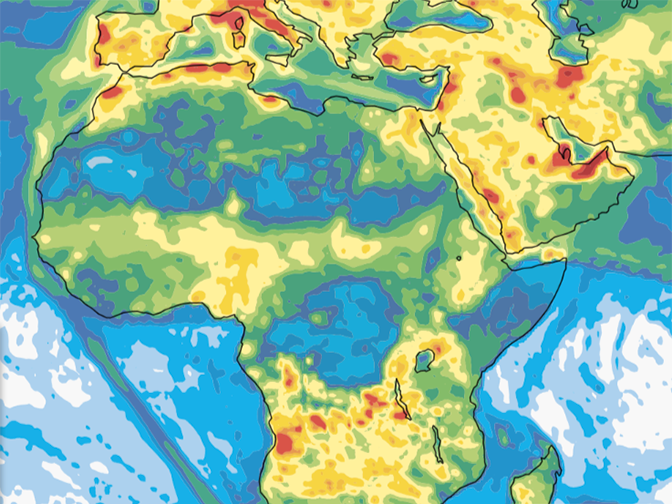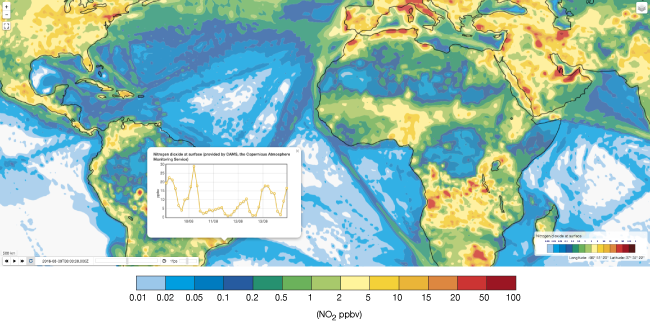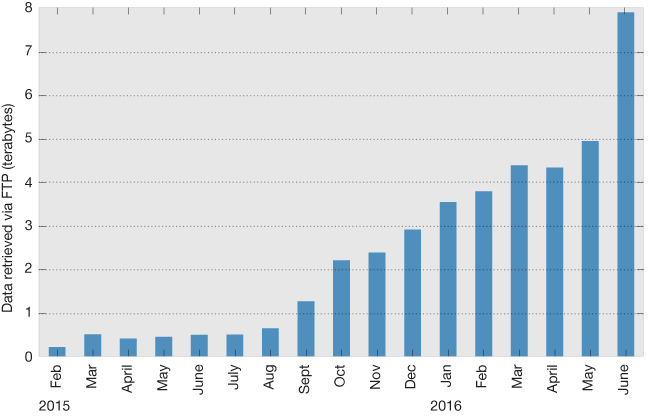

The Copernicus Atmosphere Monitoring Service (CAMS), which is operated by ECMWF on behalf of the EU, has enhanced its products and its user interface since it became fully operational last summer.
Recent enhancements include an increase in the resolution and frequency of global CAMS forecasts and a new user interface for its online catalogue.
CAMS monitors and predicts the composition of the atmosphere globally with a special focus on Europe. The service provides policymakers, businesses and citizens with reliable information on the concentration of pollutants in the atmosphere that affect air quality and act as drivers of climate change.
It uses ECMWF’s production and dissemination infrastructure to help meet the needs of its users, whilst also partnering with organisations such as national meteorological services to deliver aspects of the service.
Higher resolution
In June, CAMS launched a new version of its global forecasting system. The upgrade increased the spatial resolution of the forecasting model from 80 km to 40 km.
The improved system also produces two 5-day atmospheric composition forecasts per day instead of one. In addition to the forecast initialised at 00 UTC, there is now also a forecast initialised at 12 UTC, which is available before 22 UTC.
“The two changes mean that forecasts now provide more geographical details and are delivered to CAMS users in a timelier manner,” says Richard Engelen, the Deputy Head of CAMS at ECMWF.

The chart shows the concentration of nitrogen dioxide in parts per billion by volume (ppbv) at the surface at 0300 UTC on 24 July 2016. On the CAMS website, a point-and-click feature enables users to call up five-day forecasts for any location. High concentrations of nitrogen dioxide can affect human health.
CAMS, which is part of the EU’s Copernicus Earth observation programme, has a substantial quality control and validation component.
The CAMS validation team, which comprises many experts in the field, carefully assessed the output of the upgraded system to ensure the quality of the daily analyses and forecasts.
New interface
CAMS has also launched a new interface for its online catalogue, enabling users to find and access data with greater ease.
The new interface provides dynamic visualisations without the need to download data into specialist tools or software.
The video explains the main features of the new CAMS catalogue.
Features include animations showing users the evolution of atmospheric composition; an intuitive search system; a set of layers to choose from; and other simple point-and-click features.
“The new catalogue marks an important step in broadening access to the wealth of CAMS data,” Dr Engelen says.
“This is part of Copernicus’s mission to provide society with the information it needs to understand and adapt to our changing environment.”
Efficient production
ECMWF’s Forecasting Department takes care of the operational production of the global CAMS data generated at ECMWF.
This is done by running the Composition-IFS (C-IFS), a special configuration of ECMWF’s Integrated Forecasting System (IFS), on ECMWF’s high-performance computing facility.
“Using the same infrastructure as that used for the production of ECMWF’s weather forecasts is a very cost-effective way of producing the data,” says Martin Suttie, the Head of Copernicus Production at ECMWF.
Other contributions to CAMS, including regional forecasts and analyses, come from external partners.
The numbers involved are staggering: CAMS acquires 280 million observations every 12 hours to help produce its analyses and forecasts, and its total output amounts to 900 gigabytes of data a day.

Users are retrieving growing amounts of CAMS data. The chart shows the increase in the volume of data retrieved using the CAMS global FTP service. Much of the jump from May 2016 to June 2016 can be attributed to the move to higher resolution in global CAMS forecasts on 21 June.
Currently CAMS provides data access to its global near-real-time analyses and forecasts in two ways: via ECMWF’s web API services or using FTP protocol for time-critical applications.
The service is becoming increasingly popular with users. The volume of data retrieved using the global FTP service increased tenfold from about half a terabyte a month a year ago to about 5 terabytes in May 2016, and the trend is up.
The CAMS User Support Team is happy to answer any queries about the service.
